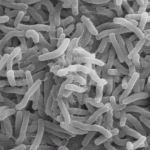Microbiology
|
18 july 2014 13:39:11 |
| Gingipains from Porphyromonas gingivalis play a significant role in induction and regulation of CXCL8 in THP-1 cells (BMC Microbiology) |
|
Tweet Background:
Porphyromonas gingivalis is an important bacterial etiological agent involved in periodontitis. The bacterium expresses two kinds of cysteine proteases called gingipains: arginine gingipains (RgpA/B) and lysine gingipain (Kgp). This study evaluated the interaction between P. gingivalis and THP-1 cells, a widely used monocytic cell line, in vitro with a focus on CXCL8 at the gene and protein levels and its fate thereafter in cell culture supernatants. THP-1 cells were stimulated with viable and heat-killed wild-type strains ATCC 33277 or W50 or viable isogenic gingipain mutants of W50, E8 (Rgp mutant) or K1A (Kgp mutant), for 24 hours.
Results:
ELISA and qPCR results show an elevated CXCL8 expression and secretion in THP-1 cells in response to P. gingivalis, where the heat-killed ATCC33277 and W50 induced higher levels of CXCL8 in comparison to their viable counterparts. Furthermore, the Kgp-deficient mutant K1A caused a higher CXCL8 response compared to the Rgp-deficient E8. Chromogenic quantification of lipopolysaccharide (LPS) in supernatant showed no significant differences between viable and heat killed bacteria except that W50 shed highest levels of LPS. The wild-type strains secreted relatively more Rgp during the co-culture with THP-1 cells. The CXCL8 degradation assay of filter-sterilized supernatant from heat-killed W50 treated cells showed that Rgp was most efficient at CXCL8 hydrolysis. Of all tested P. gingivalis strains, adhesion and internalization in THP-1 cells was least conspicuous by Rgp-deficient P. gingivalis (E8), as demonstrated by confocal imaging.
Conclusions:
W50 and its Kgp mutant K1A exhibit a higher immunogenic and proteolytic function in comparison to the Rgp mutant E8. Since K1A differs from E8 in the expression of Rgp, it is rational to conclude that Rgp contributes to immunomodulation in a more dynamic manner in comparison to Kgp. Also, W50 is a more virulent strain when compared to the laboratory strain ATCC33277. |
| 87 viewsCategory: Microbiology |
 Bacterial pathogenesis: Bartonella gets under the skin (Nature Reviews Microbiology) Bacterial pathogenesis: Bartonella gets under the skin (Nature Reviews Microbiology)Endophytic bacterial community of grapevine leaves influenced by sampling date and phytoplasma infection process (BMC Microbiology) 
|
| blog comments powered by Disqus |
MyJournals.org
The latest issues of all your favorite science journals on one page
The latest issues of all your favorite science journals on one page



